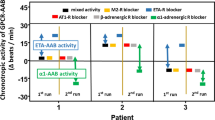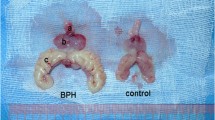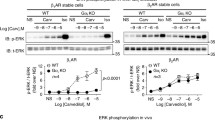Abstract
Purpose
Alpha1A-adrenoceptors are important regulators of prostatic smooth muscle tone and an important target for therapy of lower urinary tract symptoms. The function of heptahelical transmembrane receptors such as adrenoceptors can be regulated by β-arrestin-2, which may bind to receptors besides G proteins. Here, we investigated the expression and α1A-adrenoceptor binding of β-arrestin-2 in the human prostate.
Methods
Human prostatic tissues were obtained from patients undergoing radical prostatectomies. The expression of β-arrestin-2 and α1A-adrenoceptors was studied by RT–PCR, Western blot analysis, and immunohistochemistry. The protein–protein interaction between α1A-adrenoceptors and β-arrestin-2 was investigated by coimmunoprecipitation.
Results
RT–PCR and Western blot analysis demonstrated the expression of β-arrestin-2 mRNA and protein in the human prostate. Immunohistochemistry demonstrated β-arrestin-2 expression in smooth muscle and stromal cells. Coimmunoprecipitation studies demonstrated that α1A-adrenoceptors in the human prostate may interact with β-arrestin-2. Thus, specific binding of β-arrestin-2 to α1A-adrenoceptors was significantly higher than background during α1A-adrenoceptor detection in β-arrestin-2 precipitates (P < 0.001) or during β-arrestin-2 detection in α1A-adrenoceptor precipitates (P < 0.005). This interaction may be located to prostate smooth muscle cells, as expression of the α1A-adrenoceptor was exclusively found in smooth muscle cells after immunohistochemical staining.
Conclusion
With β-arrestin-2, we identified a new binding partner of the α1A-adrenoceptor in human prostate smooth muscle. Binding of β-arrestin-2 may be involved in posttranslational regulation of prostate α1A-adrenoceptors.



Similar content being viewed by others
Abbreviations
- BPH:
-
Benign prostate hyperplasia
- cDNA:
-
Copy desoxyribonucleic acid
- Ct:
-
Number of cycles
- IP3 :
-
Inositol-1,4,5-trisphosphate
- LUT:
-
Lower urinary tract
- LUTS:
-
Lower urinary tract symptoms
- mRNA:
-
Messenger ribonucleic acid
- PBS:
-
Phosphate-buffered saline
- RNA:
-
Ribonucleic acid
- RT–PCR:
-
Real-time polymerase chain reaction
- SEM:
-
Standard error of the mean
- SDS:
-
Sodium dodecyl sulfate
- 18SrRNA:
-
Eucaryotic small subunit ribosomal ribonucleic acid
References
Michel MC, Vrydag W (2006) Alpha1-, alpha2- and beta-adrenoceptors in the urinary bladder, urethra and prostate. Br J Pharmacol 147(Suppl 2): S88–S119
Roehrborn CG, Schwinn DA (2004) Alpha1-adrenergic receptors and their inhibitors in lower urinary tract symptoms and benign prostatic hyperplasia. J Urol 171(3):1029–1035
Schwinn DA, Roehrborn CG (2008) Alpha1-adrenoceptor subtypes and lower urinary tract symptoms. Int J Urol 15(3):193–199
Andersson KE (2007) LUTS treatment: future treatment options. Neurourol Urodyn 26(6 Suppl):934–947
Christ GJ, Andersson KE (2007) Rho-kinase and effects of Rho-kinase inhibition on the lower urinary tract. Neurourol Urodyn 26(6 Suppl):948–954
Rees RW et al (2003) Y-27632, a Rho-kinase inhibitor, inhibits proliferation and adrenergic contraction of prostatic smooth muscle cells. J Urol 170(6 Pt 1):2517–2522
Takahashi R et al (2007) RhoA/Rho kinase-mediated Ca2 + sensitization in the contraction of human prostate. Neurourol Urodyn 26(4):547–551
Hennenberg M et al (2008) Mechanisms of extrahepatic vasodilation in portal hypertension. Gut 57(9):1300–1314
Gurevich VV, Gurevich EV, Cleghorn WM (2008) Arrestins as multi-functional signaling adaptors. Handb Exp Pharmacol (186):15–37
Kendall RT, Luttrell LM (2009) Diversity in arrestin function. Cell Mol Life Sci 66(18):2953–2973
Hennenberg M et al (2007) Vascular dysfunction in human and rat cirrhosis: role of receptor-desensitizing and calcium-sensitizing proteins. Hepatology 45(2):495–506
Schmid CL, Bohn LM (2009) Physiological and pharmacological implications of beta-arrestin regulation. Pharmacol Ther 121(3):285–293
Deshpande DA et al (2008) Beta-arrestins specifically constrain beta2-adrenergic receptor signaling and function in airway smooth muscle. FASEB J 22(7):2134–2141
Kohout TA et al (2001) Beta-Arrestin 1 and 2 differentially regulate heptahelical receptor signaling and trafficking. Proc Natl Acad Sci U S A 98(4):1601–1606
Hennenberg M et al (2009) Vascular hyporesponsiveness to angiotensin II in rats with CCl(4)-induced liver cirrhosis. Eur J Clin Invest 39(10):906–913
Lakshmikanthan V et al (2009) Identification of beta-arrestin2 as a corepressor of androgen receptor signaling in prostate cancer. Proc Natl Acad Sci U S A 106(23):9379–9384
Yassin A et al (2006) Alpha-adrenoceptors are a common denominator in the pathophysiology of erectile function and BPH/LUTS–implications for clinical practice. Andrologia 38(1):1–12
Brown MD, Sacks DB (2009) Protein scaffolds in MAP kinase signalling. Cell Signal 21(4):462–469
Anglin IE, Glassman DT, Kyprianou N (2002) Induction of prostate apoptosis by alpha1-adrenoceptor antagonists: mechanistic significance of the quinazoline component. Prostate Cancer Prostatic Dis 5(2):88–95
Golomb E et al (1998) Induction of atypical prostatic hyperplasia in rats by sympathomimetic stimulation. Prostate 34(3):214–221
Kyprianou N (2003) Doxazosin and terazosin suppress prostate growth by inducing apoptosis: clinical significance. J Urol 169(4):1520–1525
Kyprianou N, Jacobs SC (2000) Induction of apoptosis in the prostate by alpha1-adrenoceptor antagonists: a novel effect of “old” drugs. Curr Urol Rep 1(2):89–96
Marinese D, Patel R, Walden PD (2003) Mechanistic investigation of the adrenergic induction of ventral prostate hyperplasia in mice. Prostate 54(3):230–237
McVary KT et al (1994) Growth of the rat prostate gland is facilitated by the autonomic nervous system. Biol Reprod 51(1):99–107
Acknowledgments
We thank B. Rutz, M. Perutka, and B. Stadlbauer for excellent technical assistance. This study was supported by grants of the “Förderprogramm für Forschung und Lehre” (FöFoLe) of the Ludwig-Maximilians university, Munich, Germany (grant Reg.-Nr. 654).
Conflict of Interest
None.
Author information
Authors and Affiliations
Corresponding author
Rights and permissions
About this article
Cite this article
Hennenberg, M., Schlenker, B., Roosen, A. et al. Beta-arrestin-2 is expressed in human prostate smooth muscle and a binding partner of α1A-adrenoceptors. World J Urol 29, 157–163 (2011). https://doi.org/10.1007/s00345-010-0634-3
Received:
Accepted:
Published:
Issue Date:
DOI: https://doi.org/10.1007/s00345-010-0634-3




